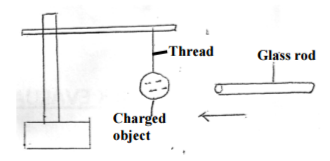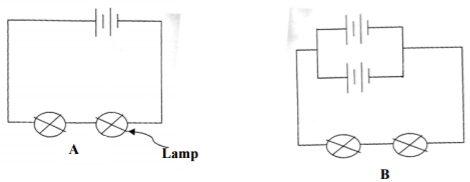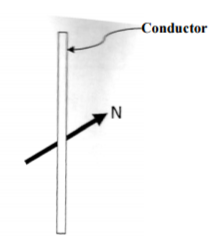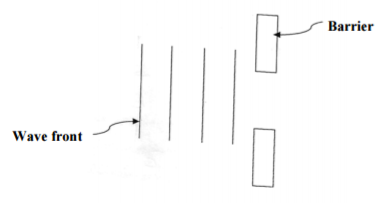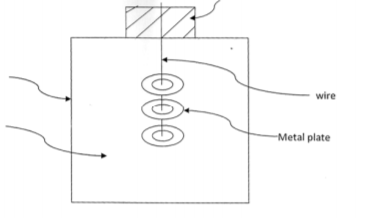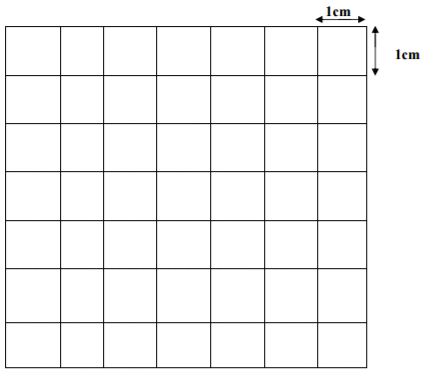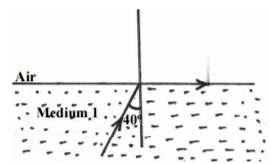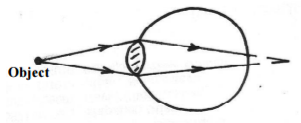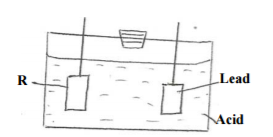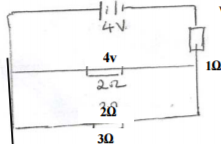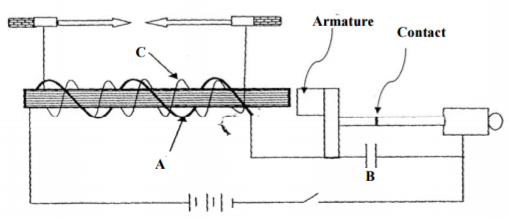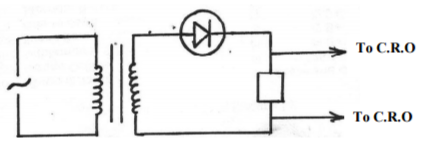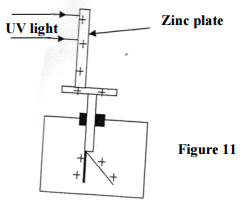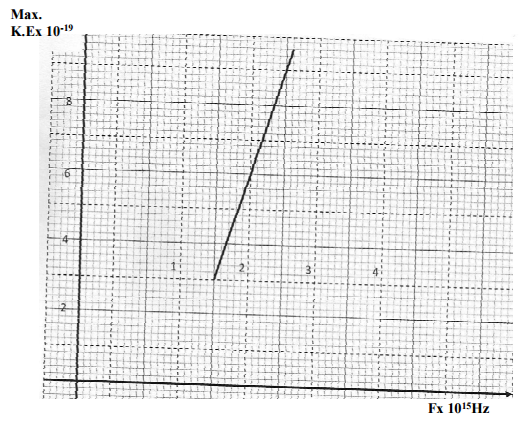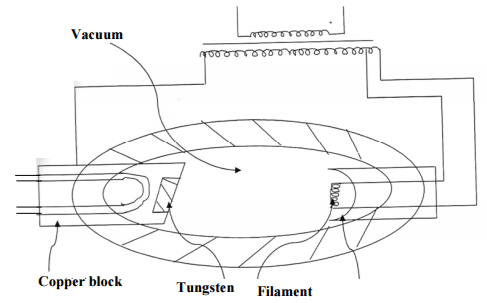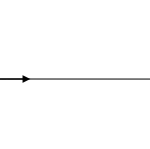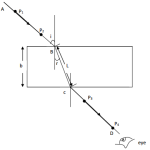KNEC KCSE Physics Paper 2 Question Paper / 2016 Pre KCSE
2016 Pre KCSE
Physics Paper 2
SECTION A (25 Marks)
Answer all questions in this section
Figure 1 below shows a negatively charged object suspended using a thread. A glass rod was rubbed
using a woolen cloth and then brought closer to the object
State the observation made when a rubbed glass rod is brought closer to the object
…………………………………………………………………………………………………………………
…………………………………………………………………………………………………………………
1 marks
In the figure below the lamps in the two circuits A and B are identical and the cells have the same
electromotive force.
Explain why the lamps in B may glow brighter than those in A when the circuits are closed at the same time
…………………………………………………………………………………………………………………
…………………………………………………………………………………………………………………
…………………………………………………………………………………………………………………
2 marks
Figure 2 shows an object placed in front of a convex lens of focal length 10cm
(a) Complete the ray and state the size of the image formed
(2mks)
(b) State one application for the above arrangement (1mk)
…………………………………………………………………………………………………………………
3 marks
(a) A compass needles is placed below a current carrying conductor as shown below
Indicate on the diagram the direction of the current (1mk)
(b) State the difference between a soft magnetic material and hard magnetic material (1mk)
…………………………………………………………………………………………………………………
…………………………………………………………………………………………………………………
2 marks
(a) Define diffraction with respect to waves
…………………………………………………………………………………………………………………
(b) In the diagram below the size of the aperture at the barrier is 10cm while the distance between two consecutive wave fronts is 3cm. if the waves are moving towards the barrier, draw the wave fronts as they appear after passing through the aperture (2mks)
3 marks
The figure below shows a set up used to study sound waves
It is observed that when the bottle is shaken sound from the metal plates is heard. State and explain the observation that would be made if a hot water is poured into the bottle than the cork is tightly replaced and the bottle shaken
…………………………………………………………………………………………………………………
…………………………………………………………………………………………………………………
…………………………………………………………………………………………………………………
2 marks
A light bulb is found to have a resistance of 800Ω when operating normally on 220 volts mains. Find:
(a) The power rating of the bulb (2mks)
…………………………………………………………………………………………………………………
…………………………………………………………………………………………………………………
(b) The value of the most suitable fuse for the bulb (2mks)
…………………………………………………………………………………………………………………
…………………………………………………………………………………………………………………
4 marks
The following are some of the electromagnetic radiations:
Ultra violet, fm waves, infared, short radio waves and micro waves
(i) Arrange the radiations in their order of increasing wavelengths (1mk)
…………………………………………………………………………………………………………………
(ii) State one use of microwaves (1mk)
…………………………………………………………………………………………………………………
…………………………………………………………………………………………………………………
2 marks
An alternating voltage of peak value 15V and frequency 25Hz is applied to the terminals of a cathode ray oscilloscope. The Y-gain is set at 5v/cm and the time base at 10ms/cm. draw the trace observed an the screen
3 marks
A resistance wire is 2m long and has a cross sectional area of 0.50cm3. if the resistance is 2.6Ω, calculate its resistivity
3 marks
SECTION B (55 Marks)
(a)(i) State two conditions for total internal reflection of light (2mks)
…………………………………………………………………………………………………………………
…………………………………………………………………………………………………………………
(ii) Figure 6 shows a ray of light travelling through medium 1 to air
Calculate the refractive index of the medium (2mks)
(b) Figure 6 shows a human eye with a defect
(i) Identify the defect (1mk)
…………………………………………………………………………………………………………………
(ii) Explain how the defect could be corrected (2mks)
…………………………………………………………………………………………………………………
…………………………………………………………………………………………………………………
(iii) Draw a suitable diagram to show the correction of the defect (2mks)
(c) Outline two differences between the lens in camera and the human eye (2mks)
…………………………………………………………………………………………………………………
…………………………………………………………………………………………………………………
11 marks
(a) Define 1Amphere (1mk)
…………………………………………………………………………………………………………………
…………………………………………………………………………………………………………………
(b) Figure 7 shows a single cell oaf a lead acid accumulator
(i) Name the electrode labeled R (1mk)
…………………………………………………………………………………………………………………
(ii) Explain how the state of charge in the cell can be tested (2mks)
…………………………………………………………………………………………………………………
…………………………………………………………………………………………………………………
(iii) State the main reason why the cell should not be left in discharge conditions for long (1mk)
…………………………………………………………………………………………………………………
…………………………………………………………………………………………………………………
(c) Figure 8 shows three resistors of values 2Ω,3Ω and 1Ω connected in
a circuit of 4 voltages
Determine:
(i) Effective resistance in the circuit (3mks)
…………………………………………………………………………………………………………………
…………………………………………………………………………………………………………………
(ii) Current through the 3Ω resistor (2mks)
…………………………………………………………………………………………………………………
…………………………………………………………………………………………………………………
10 marks
(a) What do you understand by the term mutual induction? (1mk)
…………………………………………………………………………………………………………………
…………………………………………………………………………………………………………………
(b) State two factors that determine the magnitude pf e.m.f induced in a coil (2mks)
…………………………………………………………………………………………………………………
…………………………………………………………………………………………………………………
…………………………………………………………………………………………………………………
(c) The diagram below shows an induction coil used to produce sparks
i) Name parts labeled A and function of B
…………………………………………………………………………………………………………………
…………………………………………………………………………………………………………………
(ii) Briefly explain how the induction coil works
…………………………………………………………………………………………………………………
…………………………………………………………………………………………………………………
…………………………………………………………………………………………………………………
(d) A transformer is used on a 240V a.c supply to deliver 12A at 12A to a heating coil. If 20% of
energy taken from the supply is dissipated in the transformer. Calculate the current in the primary
coil. (2mks)
5 marks
(a) What is an extrinsic semi conductor? (1mk)
…………………………………………………………………………………………………………………
…………………………………………………………………………………………………………………
(b) Figure 9 shows a PN junction diode used in a reflection
(i) What type of rectification is shown? (1mk)
…………………………………………………………………………………………………………………
(ii) Describe how the rectification is achieved. (3mks)
…………………………………………………………………………………………………………………
…………………………………………………………………………………………………………………
…………………………………………………………………………………………………………………
(iii) State two disadvantages of the rectification (2mks)
…………………………………………………………………………………………………………………
…………………………………………………………………………………………………………………
(iv) In the space provided below, sketch the output signal displayed on the CRO during the
rectification process (2mks)
9 marks
(a) Define the terms:
(i) Work function (1mk)
…………………………………………………………………………………………………………………
…………………………………………………………………………………………………………………
(b) Figure 11 shows Utra violet light striking a polished Zinc plate on a positively charged gold –leaf
electroscope
(i) Explain the observations that the leaf did not fall. (1mk)
…………………………………………………………………………………………………………………
…………………………………………………………………………………………………………………
(ii) In experiment using a photocell, U.V light of varying frequency but constant intensity was made
to strike a metal surface. The maximum kinetic energy (KE max) of photoelectrons for each frequency
, f, was measured. The graph shows how KE max varies with f
Given tha KE max= hf -Ǿ, determine the values:
(I) Constant h (2mks)
…………………………………………………………………………………………………………………
…………………………………………………………………………………………………………………
…………………………………………………………………………………………………………………
(II) Contant Ǿ (2mks)
…………………………………………………………………………………………………………………
…………………………………………………………………………………………………………………
…………………………………………………………………………………………………………………
9 marks
(a) A.G.M tube may register some effect in the absence of a radioactive source. Explain this observations and state one cause (1mk)
…………………………………………………………………………………………………………………
…………………………………………………………………………………………………………………
(b) A radioactive element A of half life 31 days decays to element B. a sample of A of mass 32g is kept in a container. Assuming B is stable, calculate the mass of B that will be in the container after 124 days
(3mks)
…………………………………………………………………………………………………………………
…………………………………………………………………………………………………………………
…………………………………………………………………………………………………………………
…………………………………………………………………………………………………………………
(c) The figure below shows the features on an x-ray tube
(i) Why is a thick copper block used at the anode (1mk)
…………………………………………………………………………………………………………………
…………………………………………………………………………………………………………………
(ii) State how the strength of the X-rays can be increased (1mk)
…………………………………………………………………………………………………………………
…………………………………………………………………………………………………………………
(iii) X-ray tube operates at 1000KV between the cathode and the anode. Calculate the maximum
energy of the X-ray protons produced. (charge of an electron, e=1.6×10-19C) (2mks)
8 marks
